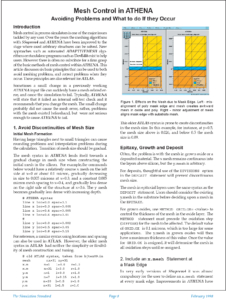Mesh Control in ATHENA
Avoiding Problems and What to do If they Occur
Introduction
Mesh control in process simulators is one of the major issues tackled by any user. Over the years the meshing algorithms with SSuprem4 and ATHENA have been improved to the stage where most arbitrary structures can be solved. New approaches such as automated ADAPTIVEMESH algorithms or standalone programs such as DevEdit exist to help users. However there is often no substitute for a firm grasp of the basic methods of mesh control within ATHENA. This article discusses six basic principles that can be used to both avoid meshing problems, and correct problems when they occur. These principles are also relevant for ATLAS.
Sometimes a small change in a previously working ATHENA input file can suddenly have a mesh-related error, and cause the simulation to fail. Typically, ATHENA will state that it failed an internal self-test check and it recommends that you change the mesh. The small change probably did not cause the mesh error, rather, problems with the mesh existed beforehand, but were not serious enough to cause ATHENA to fail.
1. Avoid Discontinuities of Mesh Size
Initial Mesh Formation



